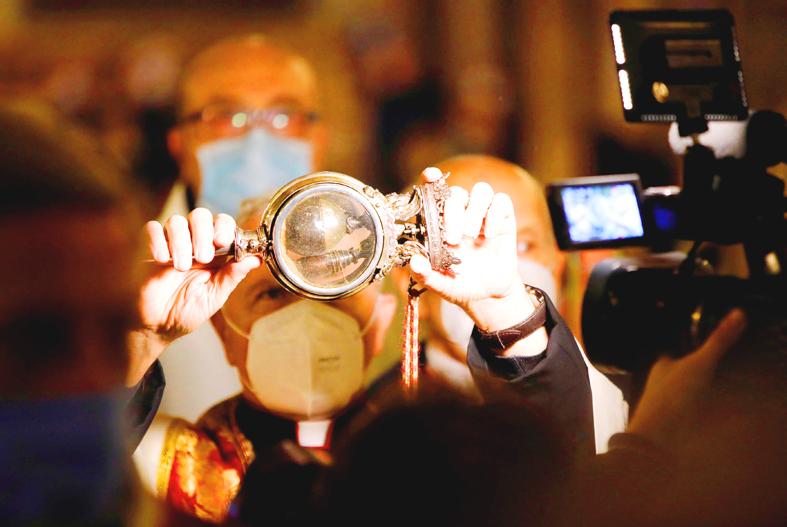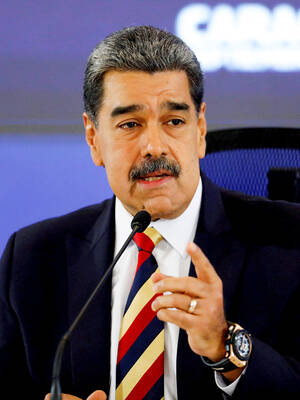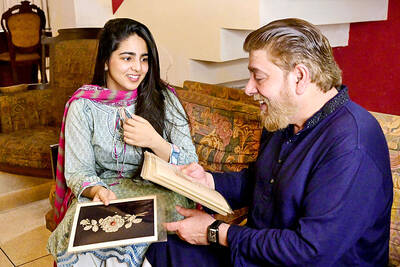Wednesday was not a good day for superstitious Neapolitans.
The blood of San Gennaro, the patron Saint of Naples, failed to liquefy, despite two rounds of praying, which some in the southern Italian city see as an omen of bad things to come.
A vial containing the dried blood of the fourth-century martyr is put on public display three times a year in the city’s cathedral and the faithful pray for its liquefication, known as the “Miracle of San Gennaro.”

Photo: Reuters
It did not happen on Wednesday, despite hours of praying in the morning and a special Mass in the afternoon.
Fewer people than normal were allowed into the cathedral because of COVID-19 restrictions.
Scientists say that the substance inside the sealed vial appears to be dried blood, but cannot explain why it sometimes turns into liquid and sometimes does not.
Neapolitans get particularly nervous if the blood does not liquefy on the saint’s feast day, Sept. 19, but less so on the other two days that the vial is brought out for public veneration — the Saturday before the first Sunday in May, and on Dec. 16.
When the blood failed to liquefy on Sept. 19, 1980, a massive earthquake hit southern Italy two months later, killing more than 3,000 people.
On Wednesday, Naples Cardinal Crescenzio Sepe told people not to be overly dismayed.
“If something needs to melt, it is the hearts of people,” he said.

‘NEO-NAZIS’: A minister described the rally as ‘spreading hate’ and ‘dividing our communities,’ adding that it had been organized and promoted by far-right groups Thousands of Australians joined anti-immigration rallies across the country yesterday that the center-left government condemned, saying they sought to spread hate and were linked to neo-Nazis. “March for Australia” rallies against immigration were held in Sydney, and other state capitals and regional centers, according to the group’s Web site. “Mass migration has torn at the bonds that held our communities together,” the Web site said. The group posted on X on Saturday that the rallies aimed to do “what the mainstream politicians never have the courage to do: demand an end to mass immigration.” The group also said it was concerned about culture,

CRACKDOWN: The Indonesian president vowed to clamp down on ‘treason and terrorism,’ while acceding to some protest demands to revoke lawmaker benefits Protests in Indonesia over rising living costs and inequality intensified overnight, prompting Indonesian President Prabowo Subianto to cancel a planned trip to China, while demonstrators reportedly targeted the homes of the finance minister and several lawmakers. Rioters entered Indonesian Minister of Finance Sri Mulyani Indrawati’s residence near Jakarta early yesterday, but were repelled by armed forces personnel, Kompas reported. Items were taken from the homes of lawmaker Ahmad Sahroni and two others, according to Detik.com. The reports of looting could not be independently verified, and the finance ministry has not responded to requests for comment. The protests were sparked by outrage over

VENEZUELAN ACTION: Marco Rubio said that previous US interdiction efforts have not stemmed the flow of illicit drugs into the US and that ‘blowing them up’ would US President Donald Trump on Wednesday justified a lethal military strike that his administration said was carried out a day earlier against a Venezuelan gang as a necessary effort by the US to send a message to Latin American cartels. Asked why the military did not instead interdict the vessel and capture those on board, Trump said that the operation would cause drug smugglers to think twice about trying to move drugs into the US. “There was massive amounts of drugs coming into our country to kill a lot of people and everybody fully understands that,” Trump said while hosting Polish President

For more than a century, the fate of the dazzling Darya-e-Noor diamond has been sealed inside a bank vault — a mystery that haunts Khawaja Naim Murad, great-grandson of the last prince, or nawab, of Dhaka. Locked away in 1908, were the family’s heirlooms lost during the violence at the end of British rule in 1947? Did they survive Bangladesh’s war of independence in 1971 and the string of coups that followed, or are they still safe, dusty, but untouched? Many suspect that the jewels are long gone and officials at the state-run bank hesitate to simply open the vault, fearing that they